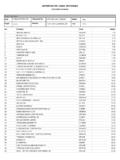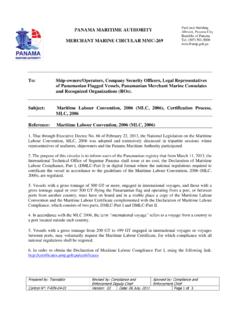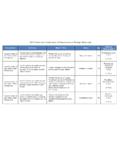Transcription of OP NOTICE TO SHIPPING No. N-1-2014 (Revision 1) - …
1 panama canal authority (ACP) Operations Department Bldg. 729, Balboa-Ancon panama , panama Vessel Requirements OP NOTICE TO SHIPPING No. N-1-2014 (Revision 1) panama canal authority (ACP) Executive Vice Presidency for Operations Bldg. 729, Balboa-Ancon panama , panama February 27, 2014 OP NOTICE TO SHIPPING No. N-1-2014 (Revision 1) To: SHIPPING Agents, Owners and Operators Subject: Vessel Requirements 1. Effective Date and Cancellation This NOTICE is effective on the date of issue and cancels OP NOTICE to SHIPPING No. N-1-2014 . A revised NOTICE will be issued in January of each year or when otherwise required. The content of this revised NOTICE remains the same, except for changes to customer service contact on page xii. 2. Purpose and Scope a. The purpose of this document is to inform the SHIPPING community of the procedures and amplifications necessary to implement the Maritime Regulations for the Operation of the panama canal (MROPC).
2 Please be advised that non-compliance with panama canal rules and regulations may subject vessels to unnecessary delays or denial of transit. The panama canal authority (ACP) may order deviations from these rules if special circumstances so warrant. Please refer to the Table of Contents on pages ix through xi. OP NOTICE TO SHIPPING N-1-2014 (Revision 1) iii3. Organization and Responsibility The Executive Vice Presidency for Operations (272-4500, fax: 272-3892), under the Executive Vice President for Operations, is the organizational department of the panama canal authority responsible for the control of maritime traffic through the canal and its terminal ports, and through which all ACP services to SHIPPING are handled. Following is a summary of the Executive Vice Presidency for Operations units which, due to their functions, often require contact with agents, operators and owners: a.
3 The Transit Operations Division (272-4211, fax: 272-4288), headed by the Transit Operations Division executive manager, is responsible for the immediate direction of daily maritime operations, emergency response and recovery, supervision and enforcement of rules and regulations governing the navigation of the canal , approval of new construction compliance with chocks and bitts, boarding facilities, wheelhouse design features and visibility requirements, and for ensuring that vessels arriving for transit are properly equipped. Additionally, the unit is responsible for matters involving the safety aspects of vessel traffic flow and control, vessel material conditions and inspections, hazardous cargo, canal physical conditions, and emergency response for fires or oil/chemical spills.
4 The responsibilities of the Transit Operations Division executive manager are exercised through the canal port captain on duty. b. The Marine Traffic Control Section (272-4201, fax: 272-3976, headed by the Traffic Management Unit manager, is responsible for processing ETA information, preparation of the daily transit schedule, monitoring and coordinating all vessel movements within canal operating areas, and administering the panama canal Transit Booking System. c. The Admeasurement and Billing Unit (272 4567, fax: 272 5514, headed by the Admeasurement Unit manager, is responsible for ascertaining the correct panama canal tonnage of vessels transiting the canal , ascertaining and auditing the Total TEU Allowance (TTA) on full container vessels and Number of TEUs Transported (NTT) on other vessels with on deck carrying capacity, maximum number of berth on passenger vessels and the maximum displacement on warships, dredges and floating dry-docks; boarding and clearing of vessels for medical surveillance, general ship inspections, gathering information for the Ship Data Bank, and generating billing invoices for transits and related services.))
5 D. The Board of Inspectors (272-3403, fax: 272-3548), headed by the Board of Inspectors chairman, is responsible for the official inquiry and examination into the circumstances surrounding marine accidents which occur in canal waters involving authority personnel and/or equipment. In addition, this office is responsible for the certification of marine credentials of authority employees. Finally, vessel transits are a joint effort. In addition to the responsibilities of the units outlined above, vessel owners, operators, agents, officers and crews are responsible for OP NOTICE TO SHIPPING N-1-2014 (Revision 1) ivcompliance with canal rules and regulations. Cooperation of all concerned parties is necessary to ensure a safe and efficient transit. 4. Communication Channels Direct communication with the Executive Vice Presidency for Operations units may be established by the following means: a.
6 MAIL: AUTORIDAD DEL canal DE panama (ACP) (Name, position and title) ACP-OP Box 526725 Miami FL 33152-6725 b. FACSIMILE: (Name of Unit) (Fax numbers listed on the previous page.) c. TELEPHONE: (Telephone numbers listed on the previous page.) d. INTERNATIONAL COUNTRY CODE For fax and telephone: 507 e. TRAFFIC MANAGEMENT UNIT Via e-mail: f. RADIO PRATIQUE MESSAGES Via e-mail: g. DRAWING SUBMITALS Via e-mail: or in compact disk or printed form directly to: Courier mail: AUTORIDAD DEL canal DE panama Divisi n de Operaciones de Tr nsito (OPTS) Edificio 910, La Boca Balboa, panama Republic of panama (Telephones: 272-4191/4296) Regular mail: AUTORIDAD DEL canal DE panama Divisi n de Operaciones de Tr nsito (OPTS) Balboa, panama Republic of panama The drawings submitted via e-mail or disk should be saved preferably in PDF or TIFF file format, or in a file format compatible with AUTOCAD.
7 All drawing and letter files are to be compressed together into one zip file using the WinZip file compression software. h. For admeasurement purposes the drawings shall be submitted to: at least 96 hours prior to arrival at panama canal Waters in PDF or AUTOCAD formats only, in one plan (not section). OP NOTICE TO SHIPPING N-1-2014 (Revision 1) v 5. Relevant Information for canal Customers a. panama canal Pilotage Regulation and Training The panama canal enjoys an excellent safety record, which is mainly due to the extensive training that is required of our pilots. In order to continue providing this excellent service, training on board transiting vessels is essential. Nevertheless, several masters have reportedly been reluctant to allow panama canal pilots in training to maneuver their vessels under the supervision and control of qualified panama canal pilots as part of their required training program.
8 In addition, a number of masters are reportedly failing to comply with instructions issued by ACP pilots and are interfering with the safe navigation of transiting vessels. Pilotage is compulsory in canal waters based on the Regulation on Navigation in panama canal Waters, which also dictates that the pilot assigned to a vessel shall have control of the navigation and movement of such a vessel. Masters should be made aware; therefore, that panama canal pilots on board vessels are in control of the navigation and are not in an advisory capacity. This control does not cease while a pilot in training is executing maneuvers under the supervision of the qualified pilot. An integral and fundamental part of their training is precisely the hands-on part, which can only be performed by allowing them to execute maneuvers and handle vessels while transiting our waterway.
9 B. Pilot Accommodations Aboard Transiting Vessels Although the majority of transiting vessels provide panama canal pilots with adequate accommodations, reports have been received of several masters who are reluctant to comply with this requirement. Sometimes pilots are required to stay on board while not actually engaged in piloting duties and they shall be provided with a cabin that is clean, serviceable, darkened and equivalent to an officer s cabin. These cabins should have a private working toilet facility. c. Vessel Requirements for New panama canal Locks The following definitions and requirements are applicable to all vessels intending to transit the new panama canal locks. Definitions: Tropical Fresh Water (TFW): Tropical Fresh Water of Gatun Lake, density tons/m at C. (Note: Transition to fresh water frequently alters trim of large vessels by the head).
10 OP NOTICE TO SHIPPING N-1-2014 (Revision 1) vi Panamax: All Supers that comply with the size and draft limitations of the actual locks; namely, meters in length by meters in beam by meters TFW draft. Panamax Plus: All Panamax vessels authorized for TFW drafts greater than meters up to meters and approved for transit of the new locks. New Panamax: All vessels with dimensions greater than Panamax or Panamax Plus that comply with the size and draft limitations of the new locks; namely, 366 meters in length by 49 meters in beam by meters TFW draft. Safe Working Load (SWL): The SWL should not exceed 80 percent of the design load. Maximum Length: The maximum length overall including bulbous bow for commercial or non-commercial vessels acceptable for regular transit is 366 meters. Vessels transiting the canal for the first time, whether newly-constructed or newly-modified, are subject to inspection and prior review and approval of vessel plans.

















